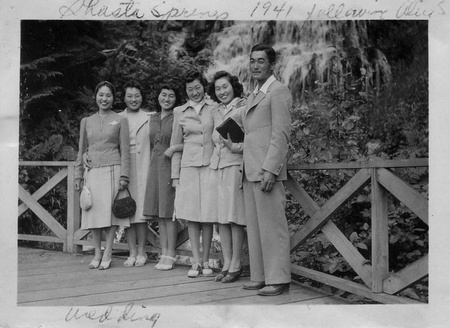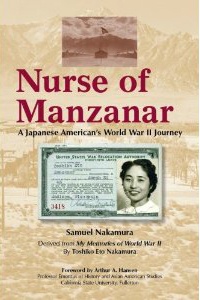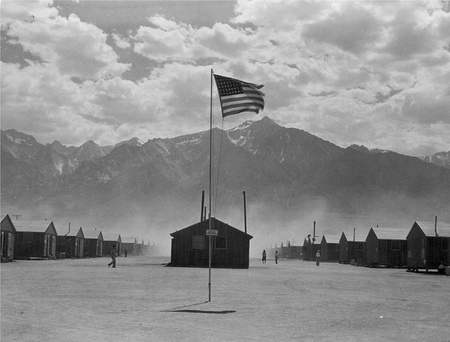Whenever I encounter a memoir such as that at the heart of Nurse of Manzanar: A Japanese American’s World War II Journey, I instinctively assay its strengths and shortcomings by viewing it through a flexible template composed of two basic questions: 1) Does the author create an interesting and well crafted narrative?; 2) Is the narrative developed by the author suffused with and sustained by a respect for historical truth?
In the present case, Toshiko Eto Nakamura satisfies both of these criteria quite admirably. Indeed, one need only read the opening paragraph in her manuscript to gain an appreciation for this opinion.
It was Sunday, and the day was clear and crisp as I walked home from my duplex apartment at 645 Park Avenue to the Mountain View Hospital, a small, twenty-five bed private facility located at 1530 Marsh Street. At 7:30 in the morning, the town of San Luis Obispo, California, still seemed asleep, except for the occasional early workers such as us nurses. The day and night nurses changed shift at eight o’clock, and we usually had breakfast at the hospital before reporting for duty. Miss Emma Righter, the superintendent of the hospital, had redecorated and improved the nurses’ dining room by adding an incline down from the first floor. One long table was in the middle of the room, seating all of the ten to twelve nurses comfortably. This room had a large, wide window with bright floral drapes. It faced the San Luis Mountain, not far away, giving a restful, pleasant view. I always enjoyed my breakfast there, although some girls complained they couldn’t eat breakfast. Maybe it was because I had a brisk eight-block walk every morning to the hospital.
In this deceptively simple nine-sentence paragraph readers are provided with an extraordinary verbal portrait of an ordinary round of activities occurring in an ordinary setting and involving an ordinary cast of characters. What renders the representation of this prosaic reality poetic is that the author punctuates her narrative description with details that are attention-grabbing (“the day was clear and crisp”), worthy-of-note (“The day and night nurses changed shift at eight o’clock, and we usually had breakfast at the hospital before reporting for duty.”), appealing (“The room had a large, wide window with bright floral drapes. It faced the San Luis Mountain, not far away, giving a restful, pleasant view.”), instructive (“Miss Emma Righter, the superintendent of the hospital, had redecorated and improved the nurses’ dining room by adding an incline down from the first floor.”), and intriguing (“I always enjoyed my breakfast there, although some girls complained they couldn’t eat breakfast. Maybe it was because I had a brisk eight-block walk every morning to the hospital.”).
But this conjoining of interesting data and literary craftsmanship constitute only one critical part of the equation responsible for Toshiko Eto Nakamura’s success as a historical memoirist. The other part, as embodied in her manuscript’s maiden paragraph, is her preoccupation with historical veracity. This penchant is communicated through specific points of fact (“duplex apartment,” “645 Park Avenue,” “small, twenty-five bed private facility,” “7:30 in the morning,” “the day and night nurses changed shift at eight o’clock,” and “brisk eight-block walk every morning”), but it also comes across in nuanced and qualified statements (“we usually had breakfast” and “Maybe it was because I had a brisk eight-block walk”), and a pervasive articulation of both a “sense of time” and a “sense of place.”
Moreover, the effect of the author’s fidelity to such facts, statements, and senses is to build up confidence in the reader that she can be trusted to maintain the same commitment to truth when discussing larger and more consequential historical developments in her memoir, such as her family’s early 1942 wartime expulsion from San Luis Obispo County and the infamous Manzanar Riot of early December 1942.

Toshi, Nancy, Grace, Mary, Susy, and Masa in June 1941. (Eto Family Files. Courtesy of Samuel Nakamura)
Beyond judging a historical memoir according to the two basic standards of interest and truth, I also employ additional evaluative criteria. One of these is the author’s ability to transcend the level of empirical fact in order to accommodate a philosophical reflection or question. Although Toshiko Eto Nakamura is not the sort of author who peppers her narrative with such lofty matters, at several places her narrative does take a philosophical turn. One of these occurs in the context of her ruminations while continuing her work at the Mountain View Hospital prior to departing San Luis Obispo to resettle with her family out of the West Coast defense area.
What puzzles me is that when it comes down to the real human needs and suffering, no one is exempt―and perhaps that is when we come nearest to mutual understanding. No matter who helps me, if I am aided in my dire need, I could not help but be deeply grateful, and my attitude towards that person would always be favorable. Is this too näive to ask, “Must human beings always suffer to realize the need for getting along with each other?” To excuse one’s acts by saying, “It’s human nature to fight and grab; it’s the theory of survival of the fittest.” To all those, I wonder, “Is human nature beyond repair? Is it beyond control from within each individual?”
Another touchstone for me in assessing the quality of a memoirist’s writings is his or her capacity for noting harsh truths without universalizing them. Toshiko Eto Nakamura passes this litmus paper test with flying colors. At one point in her memoir, for example, she baldly refers to the Manzanar War Relocation Center in eastern California, where she and her family were detained during World War II, as a “concentration camp.” Yet, at another point she clearly resists seeing all non-Japanese Americans as supporting the actions leading to Nikkei (Japanese Americans) being confined in such a place by praising Caucasian family friends from San Luis Obispo for looking after the Etos’ farm and business: “Their unpretentious kindness and concern was truly a morale builder, for surely it would have been easier for them to have not helped us, thus avoiding the criticism from the community. I could not help but notice the true gentlemen in these people, always courteous and kind, even in times like this when it would have suited their reputation better to have stayed away from us.”
* This article was originally published as the Foreword for Nurse of Manzanar: A Japanese American’s World War II Journey by Samuel Nakamura in 2009.
© 2009 Art Hansen







